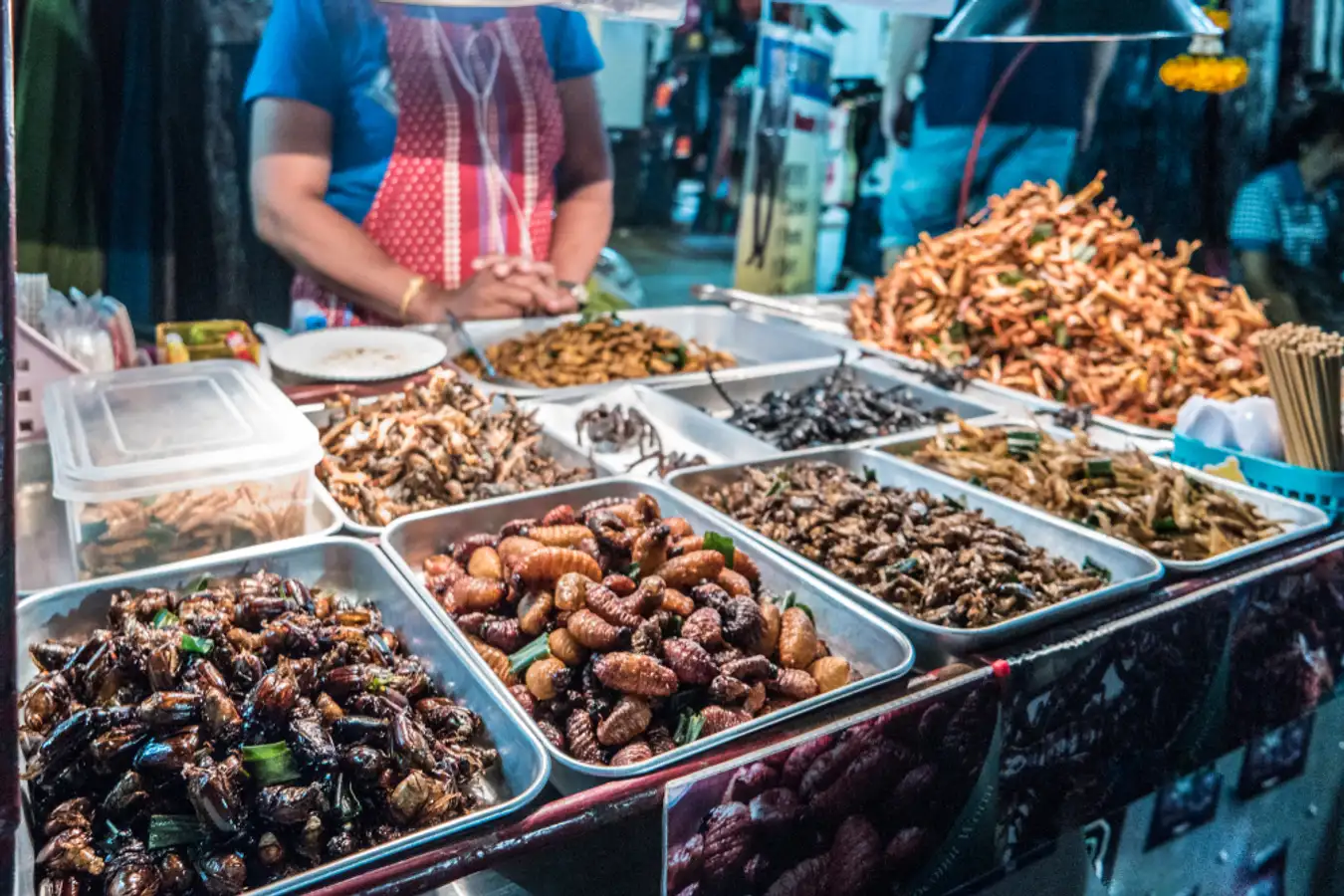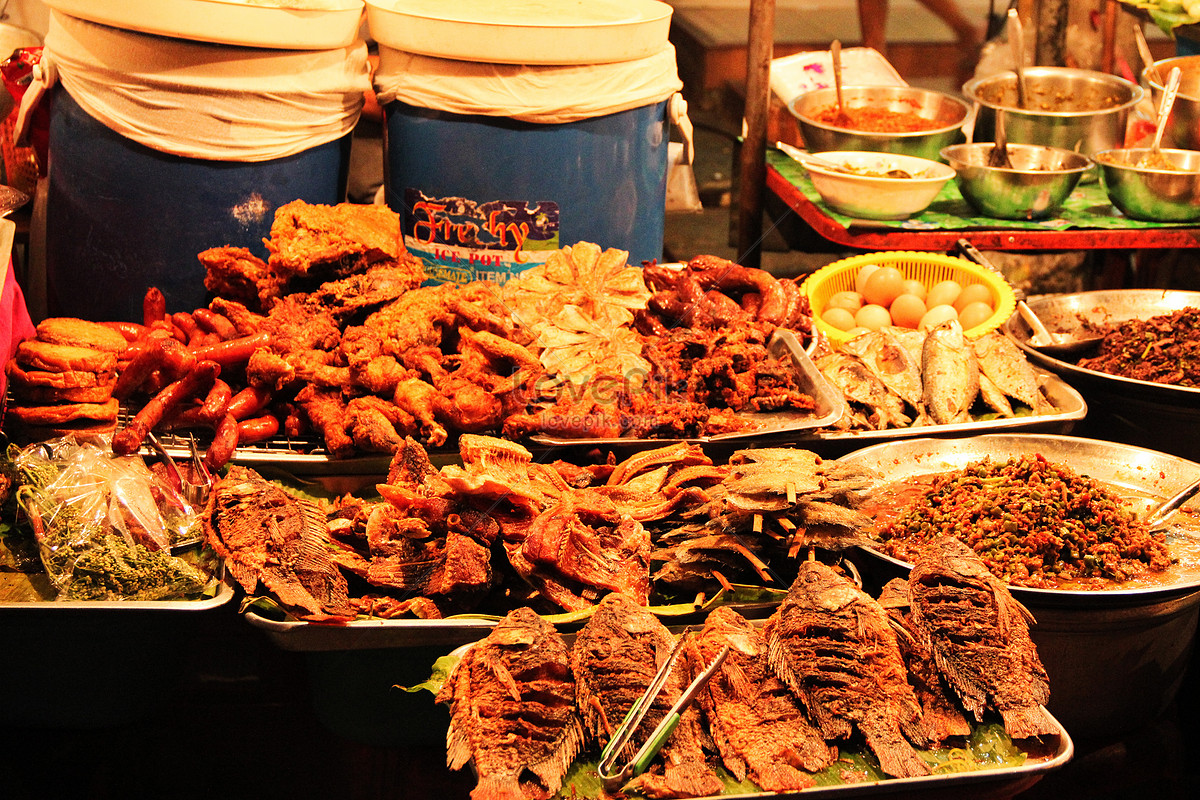Thailand’s Street Food, isn’t just a meal—it’s an experience that tantalizes the taste buds, awakens the senses, and immerses you in the vibrant tapestry of Thai culture. From bustling night markets to humble roadside stalls, Thailand’s street food scene is renowned worldwide for its diverse flavors, bold spices, and irresistible aromas. In this article, we embark on a culinary journey through Thailand’s street food, uncovering the treasures that await adventurous food lovers on every corner.
Contents
Exploring the Culinary Delights of Thailand’s Street Food

Thailand’s Street Food
A Feast for the Senses
Walking through the bustling streets of Bangkok, Chiang Mai, or Phuket, it’s impossible to resist the allure of Thailand’s street food vendors. The air is thick with the fragrant scent of grilling meats, sizzling stir-fries, and aromatic herbs and spices. Colorful displays of fresh produce, exotic fruits, and steaming pots beckon passersby to indulge in a culinary adventure unlike any other.
Signature Dishes
Thailand’s street food repertoire is as diverse as it is delicious, featuring a vast array of dishes that showcase the country’s rich culinary heritage. Some of the most iconic street food dishes include:
- Pad Thai: A beloved Thai classic, pad Thai is a stir-fried noodle dish made with rice noodles, eggs, tofu, shrimp or chicken, bean sprouts, and peanuts, flavored with a tangy tamarind sauce and aromatic spices.
- Som Tum (Green Papaya Salad): This refreshing salad combines shredded green papaya, tomatoes, green beans, peanuts, and chili peppers, tossed in a zesty dressing of lime juice, fish sauce, sugar, and garlic.
- Tom Yum Goong (Spicy Shrimp Soup): Tom yum goong is a spicy and sour soup made with fragrant herbs and spices, lemongrass, kaffir lime leaves, galangal, chili peppers, shrimp, mushrooms, and lime juice.
- Gai Yang (Grilled Chicken): Marinated in a blend of garlic, coriander root, black pepper, and fish sauce, gai yang is grilled to perfection and served with sticky rice, fresh vegetables, and a spicy dipping sauce.
- Mango Sticky Rice: A delightful dessert made with ripe mangoes, sticky rice, coconut milk, and sugar, mango sticky rice is a sweet and creamy indulgence that perfectly balances the heat of Thai cuisine.
The Art of Street Food
What sets Thailand’s street food apart is not just the taste but also the artistry and craftsmanship that go into each dish. Street food vendors are masters of their craft, skillfully preparing and presenting their specialties with precision and flair. Whether it’s the rhythmic clang of a wok, the deft hands of a noodle vendor, or the aromatic smoke rising from a charcoal grill, every aspect of street food preparation is a feast for the senses.

Thailand’s Street Food
The Social Experience
Beyond the culinary delights, Thailand’s street food offers a unique opportunity for socializing and community engagement. Street food vendors are often the heart and soul of their neighborhoods, serving as gathering spots where locals and tourists alike come together to share stories, laughter, and, of course, delicious food. Whether you’re perched on a plastic stool by the roadside or elbow-to-elbow with fellow diners at a bustling night market, the camaraderie and convivial atmosphere of Thailand’s street food scene are second to none.
Challenges and Resilience
Despite its popularity and cultural significance, Thailand’s street food scene faces challenges from urban development, hygiene regulations, and changing consumer preferences. In recent years, there has been a push to regulate street food vendors in major cities like Bangkok, leading to concerns about the loss of authenticity and character in traditional street food areas. However, street food vendors have shown remarkable resilience, adapting to changing circumstances and finding innovative ways to preserve and celebrate their culinary heritage.
A Culinary Adventure Awaits
In conclusion, Thailand’s street food is more than just a meal—it’s a celebration of culture, community, and creativity. From the savory delights of pad Thai to the sweet indulgence of mango sticky rice, Thailand’s street food offers a sensory journey through the flavors and traditions of this enchanting country. So, the next time you find yourself wandering the streets of Thailand, be sure to follow your nose, embrace your adventurous spirit, and embark on a culinary adventure that will leave you craving more. Thailand’s street food awaits, ready to delight and dazzle your taste buds with every bite.
Exploring the Advantages and Disadvantages of Thailand’s Street Food
Thailand’s vibrant street food culture is renowned worldwide, captivating locals and travelers alike with its diverse flavors, aromatic spices, and bustling atmosphere. From savory noodle dishes lunatogel to sweet treats, Thailand’s street food offers a tantalizing array of culinary delights that reflect the country’s rich cultural heritage. However, like any culinary tradition, Thailand’s street food has its own set of advantages and disadvantages. In this article, we delve into the strengths and weaknesses of Thailand’s street food scene, shedding light on its complexities and implications.

Thailand’s Street Food
Advantages of Thailand’s Street Food
- Affordability: One of the most significant advantages of Thailand’s street food is its affordability. Compared to dining at restaurants or cafes, street food is often much cheaper, making it accessible to people from all walks of life, including locals and budget-conscious travelers.
- Authenticity: Thailand’s street food offers an authentic culinary experience that captures the essence of Thai cuisine. Prepared by skilled vendors using traditional recipes and techniques passed down through generations, street food dishes provide a genuine taste of Thai culture and heritage.
- Variety and Diversity: Thailand’s street food scene is incredibly diverse, featuring a wide range of dishes from different regions of the country. Whether you’re craving spicy curries, fragrant soups, flavorful stir-fries, or refreshing desserts, you’re sure to find something to satisfy your appetite on the streets of Thailand.
- Convenience: Street food is readily available and convenient for people on the go. With food stalls and vendors lining the streets of cities and towns across Thailand, you can easily grab a quick and delicious meal at any time of day or night, without the need for reservations or formal dining.
- Cultural Experience: Dining at Thailand’s street food stalls is not just about the food—it’s also about the experience. From interacting with friendly vendors to dining alongside locals and fellow travelers, eating street food is a cultural immersion that offers insights into Thai life, customs, and traditions.
Disadvantages of Thailand’s Street Food
- Hygiene Concerns: One of the primary disadvantages of street food is the potential for hygiene-related issues. While many street food vendors maintain high standards of cleanliness and food safety, others may not adhere to the same standards, leading to risks of foodborne illness or contamination.
- Limited Seating and Comfort: Street food stalls typically offer limited seating options and may lack the comfort and amenities of traditional dining establishments. Eating street food often involves sitting on plastic stools or standing at makeshift tables, which may not be suitable for everyone, especially those with mobility issues.
- Language Barrier: Communicating with street food vendors can be challenging, especially for travelers who do not speak Thai. While some vendors may speak English or use visual menus, others may not, making it difficult to navigate the ordering process and understand the ingredients or preparation methods of certain dishes.
- Environmental Impact: Thailand’s street food culture can contribute to environmental issues such as littering and waste generation. Disposable plates, utensils, and packaging are commonly used in street food stalls, leading to increased plastic waste and pollution, particularly in urban areas.
- Regulatory Challenges: In recent years, Thailand’s street food scene has faced regulatory challenges, with authorities in some cities imposing restrictions or regulations on street food vendors. While these measures may aim to address concerns such as hygiene and congestion, they also pose challenges for vendors and may threaten the vibrancy and authenticity of Thailand’s street food culture.
Conclusion
In conclusion, Thailand’s street food offers a myriad of advantages, including affordability, authenticity, variety, convenience, and cultural experience. However, it also presents challenges such as hygiene concerns, limited seating and comfort, language barriers, environmental impact, and regulatory challenges. Despite these drawbacks, Thailand’s street food remains a beloved culinary tradition that continues to captivate food lovers around the world with its flavors, aromas, and vibrant atmosphere. As Thailand’s street food scene evolves, striking a balance between preserving its unique charm and addressing its challenges will be essential to ensuring its continued success and enjoyment for generations to come.
Read More Article About “Resource Depletion: Call Action for Sustainable Stewardship“




